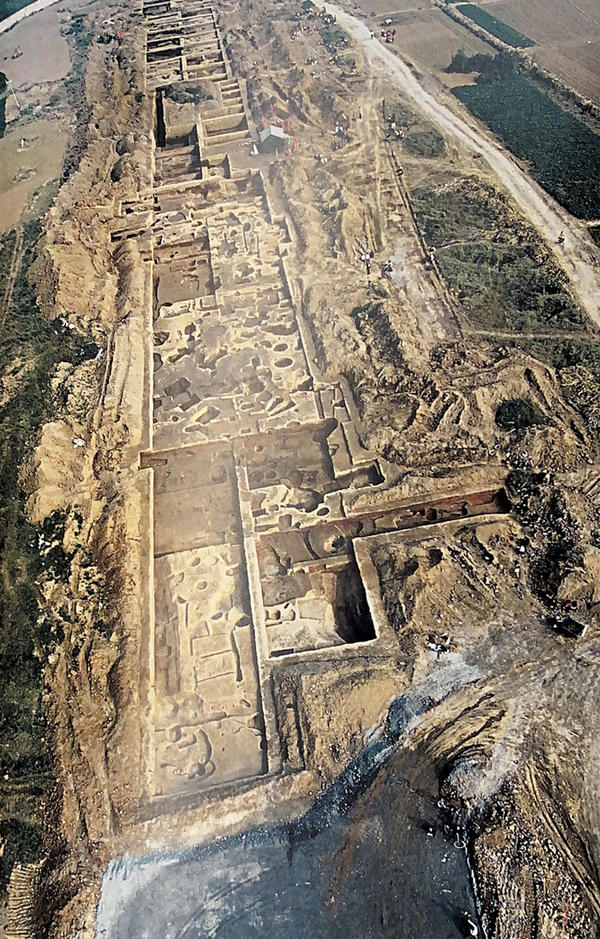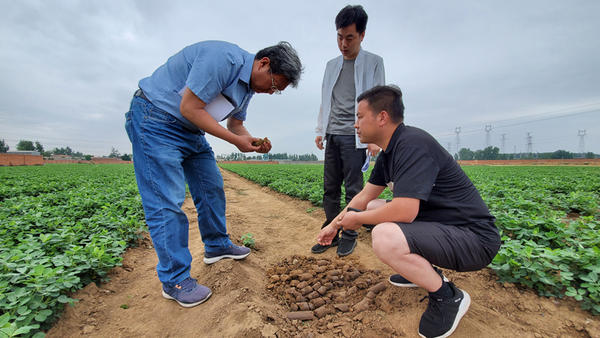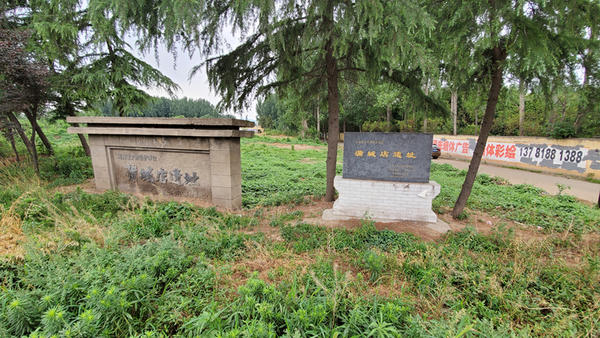To explore the culture of the Xia Dynasty (2070 BC-1600 BC) and refresh the current understanding of the two ancient cities and the cultural relics, Henan Institute of Cultural Relics and Archaeology has carried out archaeological investigations in the Shahe River basin. Now, a new round of systematic investigation of the Puchengdian Site is underway.
Click on the video
Around 9 am on June 17, on a large peanut field in Puchengdian village of Pingdingshan city, Central China's Henan province, archaeologists who had been busy for hours were still working with dozens of Luoyang spades - a traditional tube-shaped testing tool widely used by Chinese archaeologists to examine the layers of soil to locate possible underground relics. "Today is a cloudy day, a 'five-star weather' for archaeological activities." An archaeologist smiled and said that at the moment it would be too hot to work as usual. In recent years, archaeology has become a "favorite" in books, films, televisions and even news reports. However, for archaeologists, field archaeology, the most basic work, is really challenging.
The dwelling foundations discovered at the Puchengdian Site. [Photo/Henan Daily App]
The place where we were standing is called the Puchengdian Site, one of the sixth batch of national key cultural relics.
Discovered in the 1950s, the Puchengdian Site was listed as one of the first batch of provincial key cultural relics by the People's Government of Henan Province in 1963, but its values and secrets remained unrevealed until 2004, more than half a century later.
"From 2004 to 2005, because of the Lankao-Nanyang Expressway construction, we excavated the Puchengdian Site for protection purpose, with remains of different periods discovered, such as the Longshan Culture (around 2500 BC-2000 BC), the Xinzhai Phase (around 1870 BC-1720 BC), the Erlitou Culture (around 1735 BC-1530 BC), the Western Zhou Dynasty (1046 BC-771 BC), the Eastern Zhou Dynasty (770 BC-256 BC), the Han Dynasty (202BC-AD 220), etc. Particularly, two ancient cities of the late Longshan Culture and the Xinzhai Phase (or the transition period from the Longshan Culture to the Erlitou Culture) were also discovered. The city sites of the Xinzhai Phase or the early Erlitou Culture were rarely found in China at that time, so the latter should be one of the earliest discoveries of its kind then." Wei Xingtao, leader of The Puchengdian Site in Pingdingshan (a key project of the National Social Science Foundation) and deputy head of Henan Institute of Cultural Relics and Archaeology, introduced the site to us.
Wei Xingtao (left) observes soil samples. [Photo/Henan Daily App]
Deriving its name from the place of discovery - Longshan town of East China's Shandong province, the Longshan Culture dating back to 4350~3950 years ago generally refers to the cultural remains in middle and lower reaches of the Yellow River in the late Neolithic Age when both bronzes and stones were used, while the Erlitou Culture, named after the Erlitou Site in Yanshi of Henan province, is generally regarded as a key to probe into the culture of the Xia Dynasty.
What did the archaeologists find in the two ancient city ruins mentioned above?
The city of the Longshan Culture is roughly an east-west rectangle with the eastern, western and southern sections of the city wall still in existence. To its north lies the old course of the Zhanhe River. About 41,000 square meters of the city remained. The city wall is composed of the wall itself and two slopes. Outside the city wall is a wide and deep moat. The remains of rectangular houses with interconnected rooms and oval houses built with the rammed-earth foundations were found. Most of the unearthed relics are gray potteries with rich shapes. It is one of the southernmost city sites of the Longshan Culture in Central and South Henan.
The city of the Xinzhai Phase is also roughly an east-west rectangle with an area of about 52,000 square meters. Its location is on the arterial road linking the Central Plains with the Nanyang basin, which is of great strategic significance. However, very few city sites of this period have been found. Another important discovery is the remains of the row houses of the Erlitou Culture. Orderly arranged, the row houses, in large numbers, cover a broad area, which explains why they are important. The remains of more than 20 row houses (each with 1 to 6 rooms) were discovered in an area of more than 170 meters in length and 20 meters in width, reflecting the social transformation from a prehistoric settlement to a dynasty.
The Puchengdian Site. [Photo/Henan Daily App]
With fruitful archaeological findings, the project The Puchengdian Site in Pingdingshan won the second prize of the Field Archaeology Award (2004-2005) presented by the State Administration of Cultural Heritage. However, there were some regrets. Wei said, "To facilitate the construction of the Lankao-Nanyang Expressway, we just identified the city ruins and their basic structure and scope. What are the inner cities like? Do they have gates? We still do not know the answers yet."
The opportunity has come. In 2020, a key project (2020-2024) themed the study of the Xia Dynasty jointly applied for by Henan, Shanxi, Anhui and Shaanxi was approved by the State Administration of Cultural Heritage. The project aims to provide scientific evidence for the comprehensive restoration and construction of the establishment background, society and history, civilization achievements, political structure and national system of the Xia Dynasty, and find out the answers to the important academic issues, such as the historical position and role of the Xia Dynasty culture in the civilization process of the Central Plains and the overall process of the integration of diversified ancient Chinese cultures.
"To better study the culture of the Xia Dynasty, we have carried out archaeological investigations in the Shahe River basin. More work is needed for the Puchengdian Site. Now, the systematic investigation is underway. We hope to gain a deep understanding of the cultural implications of the site with the remains of the two cities and other cultural relics. It is predictable and worth our expectation." Wei told Henan Daily. (Chinese source: Henan Daily App Reporter: Huang Hui Li Yue Translator: Zhao Hanqing Video: Wang Junyi Proofreader: Chen Xingjie Bai Yujie)
Related reports
The Xia Dynasty Travel Episode II The Dongzhao Site in Zhengzhou: 'Bridgehead' of the Xia Dynasty
The Xia Dynasty Travel Episode VI The Xinzhai Site in Xinmi: The First Capital of the Xia Dynasty?
The Xia Dynasty Travel Episode VII The Yuzhuang Site: Unveiling the Noble Life 4,000 Years Ago
The Xia Dynasty Travel Episode IX The Erlitou Site in Yanshi: A 'Dynasty' in a Small Village





